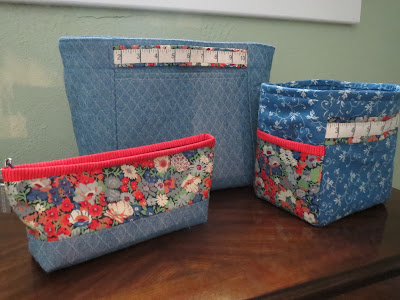Mabel Mae is my Great Granny Squared quilt, quilted and bound. The pattern is by Lori Holt of Bee In My Bonnet and is easy enough for a beginner. I made it from fabric I had on hand (2020 is my year of stash busting), even the backing and binding are from my stash.
I modified the border design and my quilt is roughly 57" by 70" after quilting.
Mabel Mae was quilted by Karen Thompson using a pantograph design of a leafy vine.
I used a pale green floral for the binding. It puts a stop at the edge without announcing it presence so all the focus is on the blocks.
The backing is a floral/ticking stripe combination, likely added to my stash when I was in my shabby chic/cottage design phase.
I asked for name suggestions when I showed you the finished top and Ellen in Oregon's suggestion of Sweet Granny got me thinking why not name the quilt after one of my great grandmothers.
Mabel Mae Roberts Briggs Seger was my mother's maternal grandmother. My mother is the child in the photo below, with her mother, her two grandmothers, and the three great grandmothers that were still alive at the time (this must have been taken in 1936); Mabel is on the far left in the back row. Mabel was born in 1883 in Wolverine, Michigan, a logging town in the northern part of the lower peninsula. She married Joseph Briggs in 1903 and had three daughters; the eldest, Ruth, was my grandmother. They moved to Lansing around 1914 and opened a dry goods store. After Joseph died, Mabel continued to run the store and later, was married again, to Art Seger. Mabel died in 1958.
Mabel was a quilter and her quilts were well-used so few have survived to today, but my mother does have a few. My grandmother sewed as well but once the Depression and World War II were over, and consumer goods were back in stores, they did not do much sewing as they associated it with having to "make do" and felt they did not need to do that any longer. My mother is a great cook but never liked the sewing part of home economics; when I see her, she often has something for me to fix or a pair of pants to hem shorter. When I was in junior high, all the girls had to take home ec (the boys had workshop) and I enjoyed the sewing part. In the lead up to the bicentennial in 1976, there was a refocus on traditional Americana, including quilting, and that's when I became interested, though I did not get totally immersed until about 1992, and obsessed shortly thereafter.
An aside about the family photo above. When I worked in the skincare industry, I used the picture to illustrate how expectations of aging have changed. The three great grandmothers in the middle of the back row were in their early and mid 70's at the time the photo was taken. The two grandmothers were 53 and 55. All I can say is thank goodness I have tretinoin, sunscreen, and advanced moisturizers!



























